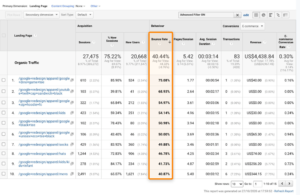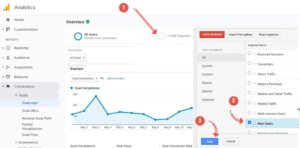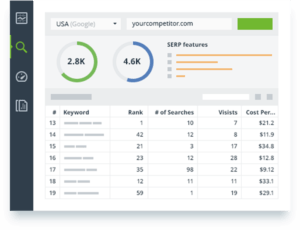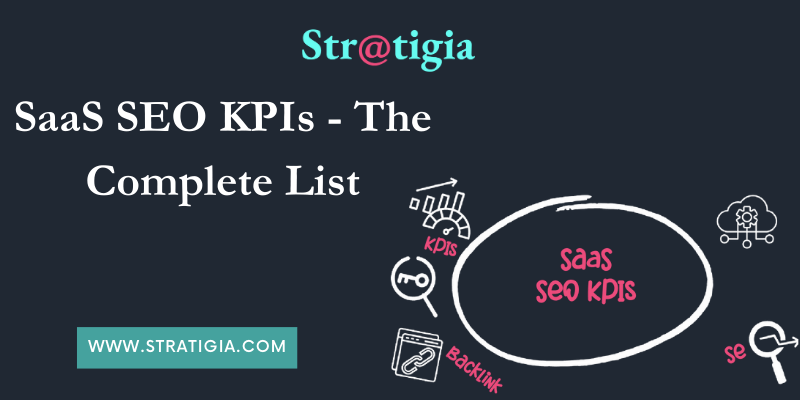SaaS companies run multiple SEO campaigns to get their desired outcome: organic search traffic, higher conversion rates, and revenue growth.
They invest time, capital, and resources in devising a winning SaaS SEO strategy. Their SEO efforts are focused on keyword ranking, creating product landing pages, and meeting their target audience’s search intent for increasing traffic on their website. However, their hard work may fail to produce the desired results, or they might wish to improve their strategy. In that case, they can’t do without one critical step: tracking their SaaS SEO KPIs.
If you have run multiple SEO campaigns but have no idea how successful or unsuccessful they were, it is high time you pay attention to assessing your action plan against the results you achieve. Not only is this important to develop impact-driven SEO, but it is also necessary for the long-term growth of your SaaS company.
Curious to find out more about SaaS SEO KPIs? Keep reading. We are going to explain what SEO KPIs are next. Then, we’ll follow it up by exploring five key performance indicators you should track to determine your SEO ROI (return on investment) and the success of your SEO campaigns.
What are SEO KPIs?
Every strategy you implement has some metrics you rely on to measure its success. Likewise, SEO KPIs are digital marketing metrics that you can use to ascertain the performance of your SEO strategy. Consider it as a yardstick against which you measure the outcomes of your campaign and decide whether you have met your targets or not.
The first step is to decide what you want to achieve through a particular SEO campaign. For example, is it improved search engine ranking, revenue boost, or any other result? Then, clarify the process you will follow to attain your goal; this can include strategies to boost search results, improve your social media presence, technical SEO, add target keywords, or any other task.
Undergoing this process will help you set a clear vision from the get-go. Then, as you gain clarity about what you want to see at the end of your campaign, you can define the metrics against which to measure your performance. Consequently, you can ensure that your marketing approach matches your vision at every step.
7 SaaS SEO KPIs to Track
SEO teams may become overwhelmed by too much information out there about the failure and success rate of SEO strategies. Therefore, it is important to know which indicators to track to improve and lock the best SEO results.
Below, we share with you a list of SEO KPIs that digital marketers can track to define more specific goals, measure the performance of their SEO campaign, and boost their overall success.
1. Organic Traffic

A vital part of SaaS SEO is to get organic traffic. According to BrightEdge, 53.2% of all website traffic comes from organic searches. This statistic alone is reason enough for SaaS companies to track the metrics and find out the performance of their content pieces. The numbers will offer clear insights into how well your target audience receives a blog or listicle.
You can also categorize your content types according to the traffic each gets. For instance, shorter blogs may attract more visitors while your long-form content may be underperforming. Again, tracking the stats will help you assess the performance and discover where you may go wrong. You can then tweak your content development plans accordingly. For example, you can launch action plans such as including more target keywords or adding images, or improving the technical SEO aspect of a blog, so it gets more search results.
Once you categorize your website traffic by content types, you can work on your organic acquisition model – a model SaaS companies use to measure how their organic efforts attract, convert, and close leads successfully. You will gain insight into this process by tracking your organic traffic metrics. It will help you improve your marketing funnel so your SaaS product sells more.
2. Bounce Rate

The bounce rate tells you how often a visitor shows up on your SaaS website and its various landing pages without engaging or interacting with it. They may not spend long on the page and may leave without exploring other pages on the website. Bounce rate gives you a percentage of visitors who exit your website without engaging with it.
Finding your bounce rate is vital if you want to know where your website is going wrong. According to Ahref, a bounce rate between 40-60% is average. A number below it is alright, but if it’s higher, you need to look into the matter. Usually, a higher bounce rate indicates a bad user experience. For example, it may mean that the page did not meet the visitors’ search intent or that they encountered technical issues such as slow loading speed or page errors.
Overall, a higher bounce rate contributes to poor search ranking. This means you ought to keep track of it diligently. You can use Google Analytics for this purpose. It uses tracking tags to save the bounce rate data on those web pages where the tags are installed. Once you have the stats in hand, you can work on improving the bounce rate through strategies that improve user experience, engagement, site speed, and more.
3. Backlinks

Backlinks contribute directly to better search results. How? Well, if your website has a high number of backlinks from other authoritative and high-quality websites, it is likely to rank higher on search engines. It will also perform better when it comes to organic search.
Link building is one of the core aspects of SEO campaigns. High-quality backlinks satisfy these requirements: relevance, traffic, authority, and uniqueness. As a digital marketer, you can set KPIs to measure the number of backlinks to your SaaS website. You can also keep a check on the referring domains – which means web pages from which your website has backlinks.
You can also choose one of several available tools to measure the growth of your backlinks. This is important if you are developing a long-term SEO strategy as it helps you assess if your backlinks grow over time. You can also check the referral traffic on Google Analytics to learn about the sources your visitors use to land on your website.
4. Conversion

Many SaaS companies launch SEO campaigns with the intent to gain more users – that is, increase their conversion rates. In this case, it is important to track their total conversions as a KPI. This metric lets you know how many leads your website generates. In addition, there is an option called ‘conversion by source.’ You can find out where your conversions originate; once you know this detail, you can focus your SEO strategy on getting more organic conversions from the same source.
Finding out the conversion rate and its source is vital because it helps you gain insights into where your website traffic comes from. In addition, knowing the traffic sources empowers you to concentrate your SEO efforts in the right direction. As a result, you can boost your organic conversion rates and referral conversions.
Organic conversions are about leads or sales you gain from ranking high on Google’s search results. In contrast, referral conversions come from backlinks on a social media page (such as Facebook) or another website. Combined, they help you boost your SEO ROI pretty quickly.
5. Keyword SERP Ranking

Keyword ranking is all about ranking on Google for a particular keyword or group of keywords. It is pretty specific and helps you meet the search intent of your niche audience. However, the overall outcome is the same: increased organic traffic on your website. SERP (Search Engine Results Page) determines your website’s ranking on Google’s first page.
According to Ahref, 60.67% of all searches come from 0.16% of the most popular keywords. Therefore, it is important to assess the success of your campaign in terms of how well its keywords rank, particularly when you run an SEO campaign. Conducting a SERP analysis helps you discover the top-ranking pages on the first page of a search engine. This way, you can learn how well a specific keyword ranks and ascertain how difficult or easy it would be to rank higher than your market competitors.
If your campaign focuses on boosting your keyword SERP ranking on Google, you can measure it through Google Search Console. You can also use Ahrefs SERP Checker to find out how much organic traffic the top results on Google get from using specific keywords.
Conclusion
Launching an SEO campaign for SaaS companies is only the first step. Next, keep tracking and measuring your performance to get verifiable results and secure long-term growth. This is how you can improve your SEO strategy. It is also how you can gain the benefits you had hoped for when you started your particular SEO campaign.
As you set out to track your performance, consider the list of SEO KPIs we have shared above. They will help you get quantifiable values to ascertain your campaign’s success. If you are looking for professional help with your SEO strategy, contact us at Stratigia. We provide tailored SaaS SEO services to boost your digital marketing efforts and get your SaaS company greater visibility, search ranking, and revenue.




